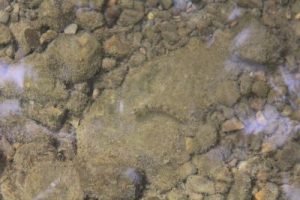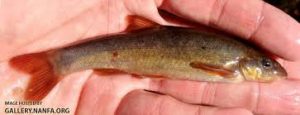10/2/20 from 1:30 p.m. – 2:15p.m.
 Sit spot location (Tinker Mountain)
Sit spot location (Tinker Mountain)
The organisms I chose were the minnows I saw the most from each visit at my sit spot. I always find them congregated in the main riffles and eddies in the creek, directly in front of my sit spot. After further research and observations, I found out this specific type of minnow is a Rhinichthys cataractae, or longnose dace. I chose to do further investigation on these organisms because they were so abundant in my area of the sit spot compared to other organisms that were in the creek. I wanted to learn more about their habits and characteristics as I watched them during my sit spot time.
The minnows are between 3-4 inches long and have spots along their backs and sides. They were a jumble of yellows, greens, browns and orange- all together giving them a murky type of coloring. Their fins came out to be orange-brownish and were very small compared to its body. As they swam around, they did not use their pectoral fins as much but mainly controlled their movement with their tail everywhere. They are not evenly proportioned fish-the space between their head and dorsal fin looked almost more than two inches from the dorsal fin. I was able to grab one quickly to look more closely at its mouth (It took me several tries but I was able to snatch one before it popped out between my fingers- it was really hard to grab!). Its mouth sat directly on the bottom part of its head and did not angle up. It made a complete circle when opens and puckered out like a plunger. As I said before, they were all extremely fast and did excellent in both eddies and riffles. They were able to torpedo themselves safely through riffles in order to get into eddies by only directing themselves with their pectoral fins. They did show me their adaptation that I had expressed in my previous blog, on their ability to latch onto rocks in eddies and in riffles and completely lay still and remained balanced. They were completely camouflaged once on the rocks and could stay there for about a minute before moving down the riffle or to another rock. I did watch a few catch small bugs that landed on the water’s surface of the eddies. They launched their bodies of the waters like mini great white sharks, only their landings created more of a water drop sound then a wave (but to them, they are gigantic).
The Rhinichthys cataractae or Longnose dace is one of the most distributed minnow species in North America. They are typically used as a beacon of indication that that body of water is clean and healthy due to their vulnerability to pollution and temperature fluctuations. They spawn within May to early June. The females will lay their eggs in cavities between rocks and the males stay throughout protecting the area. This species is commonly confused with the Blacknose dace which is its sibling. The only difference between the two types of minnows are the markings where one is spotted slightly and the other has faint stripes along its sides. The Longnose dace are found in riffle sections of creeks, streams and rivers that contain boulders, cobbles, and gravel bottoms. From this, their main diet are invertebrates found in the crevasses between the rock features. Due to these minnows’ body structure, they have become very well adapted to living along the bottom in flowing water. The main reason for this is because of their small air bladders, that compared to their body size, prevent the fish from needing to waste more energy in buoyancy. Also, the structure of their mouth and pectoral fin placement allows them to latch on the rocks by creating friction or suction. This makes it easy to obtain food by the placement of their mouth and ability to vacuum up what they want.
 Longnose dace showing its adaptation to latch onto rocks using its mouth and pectoral fins.
Longnose dace showing its adaptation to latch onto rocks using its mouth and pectoral fins.
I was able to identify the organism by looking at Virginia breeds and types of minnows. I then looked up on each site types of minnows found in creeks, types of minnows with spots, and types of minnows that can sit on rocks and the longnose dace came up every time! It was difficult at first because there are so many types of minnows so I had to be very specific on my searches and findings. Overall, it was actually very interesting and fun looking at all the types of minnows while searching for mine and discovering so many different types of fish I didn’t even know were around here! It was challenging but once I was specific enough, it became very easy to find what I needed.
This experience was so much fun! I really enjoyed being able to just stay up close with these minnows and really be able to observe their behaviors and characteristics. I lost track of time doing this-mainly because it took me a few tries to catch one. I really liked being able to do the research and learn more about this minnow but also being able to properly identify was rewarding. I thought these fish were really interesting to learn about and observe!

 Additional photo of Longnose dace to show size compared to a human hand.
Additional photo of Longnose dace to show size compared to a human hand.
Hi Amy,
I enjoyed reading through your species summary. I have always tried to catch minnows anytime I go to the river, but as always I am never able to do such a thing. It fascinates me how tiny, yet important these little guys/girls are to rivers. The long nose dace seems like a neat creature itself, I did not know that there were more than one species of minnows. I will most defiantly search in the river the next time I go and see if I am able to identify the differences between the two species.